![Ultimate Guide to [Top 19] LMS for K-12 Education - Revolutionize School Classrooms](https://blog.edmingle.com/wp-content/uploads/2023/12/Ultimate-Guide-to-Top-19-LMS-for-K-12-Education-Revolutionize-School-Classrooms.webp)
If you’re looking to revolutionize your school’s classrooms, you’ve landed in the perfect spot. But why is a K-12 LMS is so pivotal?
Today, the world of K-12 education is undergoing a seismic shift as teaching transcends traditional boundaries.
And at the heart of this change is the revolutionizing power & innovative use of learning management software.
In this comprehensive guide, we’re diving deep into the ocean of Learning Management System options tailor-made for K-12 education. Furthermore, we’ll explore how these platforms are redefining the educational landscape, one digital classroom at a time!
What is an LMS for K-12?
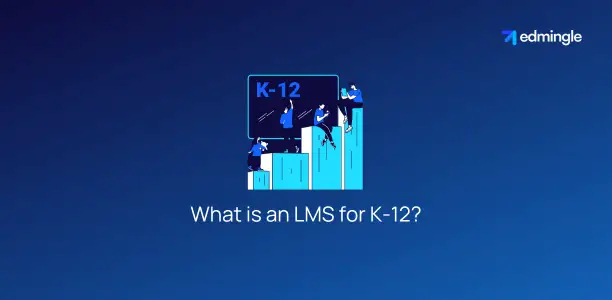
An LMS for K-12 is not just a regular learning management system. But one that’s designed specifically to meet the needs of primary & secondary school students.
It acts as a virtual classroom that extends beyond the traditional school walls, facilitating online learning, classroom management and personalized learning experiences.
These systems enable teachers to create, deliver, and manage lessons and online courses, while also allowing for the tracking of student progress and performance.
For students, it offers an interactive and engaging learning environment where they can access study materials, submit assignments, and participate in discussions, all tailored to their level.
An LMS for K-12 supports diverse learning styles and paces, making education more inclusive and accessible.
It’s a pivotal tool in enhancing communication between teachers, students & parents, and preparing students for the digital world.
Why is there a Need of an LMS for K-12 Education in Schools?
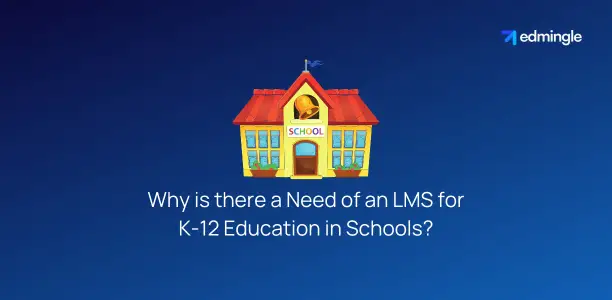
With the increasing shift towards digital learning, a learning management system bridges the gap between traditional classroom teaching and modern educational needs.
This structured and efficient platform makes even remote learning more accessible, engaging, and tailored to individual student needs.
An LMS in K-12 schools is the key to unlocking a more interactive, flexible, and effective educational environment in schools.
Challenges Faced by Online Classes and K-12 Education
Need arises from scarcity/challenges.
Similarly, online classes & specifically, the ones in K-12 educations face a plethora of challenges in order to achieve their set learning outcomes. Some of these are:
| 1. Lack of a structured and interactive platform, leading to disengaged students and overwhelmed teachers. |
| 2. Absence of personalized learning paths make it difficult to cater to the varying needs and learning paces of individual students. |
| 3. Challenges in tracking and assessing student performance effectively. |
| 4. Varying levels of access to technology among students which hinders the equitable distribution of educational opportunities. |
A modern SaaS LMS addresses these challenges effectively while ensuring a more inclusive online education/learning experience.
8 Key Features of an LMS for K-12 Education
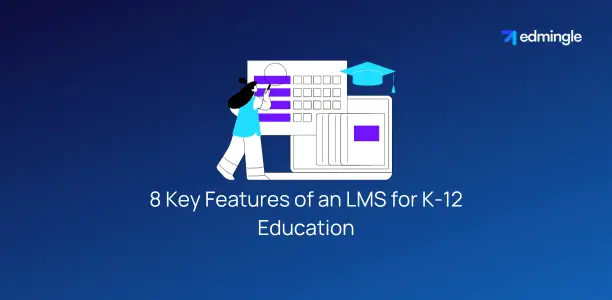
The key features of an LMS (Learning Management System) for K-12 education are tailored to cater specifically to the needs of primary and secondary education.
The following features ensure an effective and engaging learning experience in schools:
- Age-Appropriate Content Management: The ability to create, organize, and distribute age-appropriate learning materials is crucial. This includes interactive elements like videos, quizzes, and gamified content that appeal to younger students.
- Progress Tracking and Reporting: An LMS for K-12 must have robust tools for getting insights on student progress and performance. This feature allows educators to monitor individual student success and identify areas where students may need additional support.
- Collaboration Tools: Features that facilitate collaboration among students, such as discussion forums, group projects, and peer-to-peer feedback, are essential. They encourage social learning and enhance communication & other soft skills.
- Parental Involvement Features: Tools that enable parents to track their child’s academic progress and communicate with teachers are vital. This fosters a home-school connection that is very critical in K-12 education.
- Customizable Learning Paths: The ability to tailor learning paths according to individual student needs and styles is important. This personalization can help cater to diverse abilities and paces.
- Accessibility and Inclusivity: The LMS should be accessible to all students, including those with disabilities. This means compatibility with assistive & mobile learning technologies and adherence to accessibility standards.
- Integration Capabilities: The ability to integrate with other educational tools and systems like student information system or a school library management system is important for a seamless school-like experience.
- Safety and Privacy: Given the age of the users, robust LMS security features are non-negotiable. This includes secure logins, data encryption, and compliance with child protection laws.
By focusing on these key features, a learning management system truly becomes an LMS for K-12 education. And in the process, provides a comprehensive learning environment that meets the unique needs of younger learners.
5 Special Benefits of a K-12 LMS for Schools
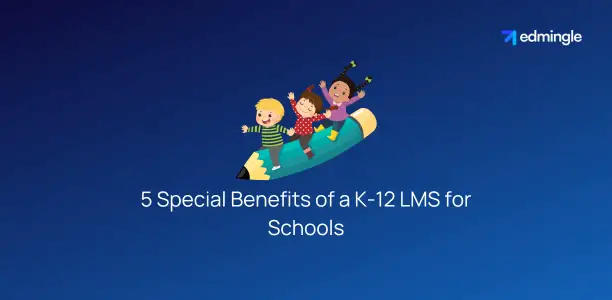
A K-12 learning management system offers several tailored benefits that are crucial for primary and secondary educational institutions:
1. Enhanced Learning Experience:
LMS platforms provide interactive and engaging educational experience and content suitable for young learners. Thereby, contributing to a more dynamic and enjoyable learning experience.
2. Streamlining Administrative Tasks:
An LMS significantly reduces the time and effort required for administrative tasks. It automates processes like attendance tracking, grade recording & scheduling. And hence, allowing educators to focus more on teaching and less on paperwork.
3. Improved Parental Involvement and Communication:
LMS platforms facilitate better communication between schools and families. Parents can easily track their child’s progress, receive updates & communicate with K-12 teachers, which enhances the home-school connection.
4. Bridging the Gap On Time:
Teachers can monitor student performance and learning outcomes more effectively, enabling them to provide timely interventions and support where needed. This could also be in the form of creating a balance between screen-time & hands-on learning.
5. Holistic Development:
These systems often include powerful tools for peer collaboration which promotes teamwork. And in the process, leads to the holistic development of a child/student.
These benefits highlight how a K-12 learning management system can transform the way education is experienced today.
10-Step Guide to Develop Effective Content for a K-12 LMS

Developing content for a K-12 LMS involves a strategic and thoughtful approach. And with this 10-step guide, it gets way easier.
For young learners, it is essential to ensure that the learning material is not only educational but also engaging and appropriate for young learners.
So without further ado, here are the essential steps and considerations:
- Step 1: Align with Educational Standards. Ensure that your content aligns with national or regional educational standards. This ensures that the material is relevant and meets the required learning objectives for each grade level.
- Step 2: Understand Developmental Stages. Tailor the content to suit the cognitive, emotional and social development stages of the K-12 age group. Content for younger students should be more visual and interactive, while older students can handle more complex and text-heavy materials.
- Step 3: Incorporate Interactive Elements. Engage students with interactive elements such as quizzes, puzzles, and games. These tools can make learning more enjoyable and can improve knowledge retention.
- Step 4: Use Age-Appropriate Language. The content should use language that is suitable for the age group it is intended for. Younger children need simpler, more straightforward language, while older students can understand more complex terms and concepts.
To learn more about their language capabilities, check our blog on LMS for Language Teaching.
- Step 5: Focus on Visual Learning. Include visual aids like images, infographics, and videos. Visual learning is highly effective for K-12 students as it helps in better comprehension and retention of information.
- Step 6: Incorporate Real-World Examples. Use examples and case studies that are relatable to the students’ everyday lives. This makes the learning more relatable and easier to understand. Additionally, this gives a sneak peek into the real-world application of a topic.
- Step7: Ensure Accessibility. The content should be accessible to all students, including those with disabilities. This includes providing subtitles for videos, audio descriptions for images, and ensuring screen-reader compatibility.
- Step 8: Feedback and Assessment Tools. Include tools for feedback and assessment to track student progress. This could be in the form of short quizzes, reflective questions, or interactive assignments.
- Step 9: Teacher and Parental Guides. Provide guides for teachers and parents to help them understand how to use the content effectively to support the student’s learning process.
- Step 10: Regular Updates and Relevance. Keep the content updated and relevant to the current educational trends and technologies. This keeps the learning material fresh and engaging.
By focusing on these key aspects, content developed for a K-12 LMS can be both educational and engaging. Thereby, leading to improved learning outcomes.
Top 19 LMS for K-12 Education

The world of learning management systems for K-12 education has a plethora of options. And, finding all about them is really challenging.
Hence, to help you make a better informed decision, we’ve compiled a list of the top 19 LMS platforms, each bringing unique features and benefits to the K-12 learning environment.
1. Edmingle
Edmingle offers an intuitive interface with a wide range of useful features & tools for delivering interactive and engaging learning experiences. It’s a cloud-based/SaaS LMS, well known for excellent parent-teacher communication features, making it highly suitable for K-12 schools.
Furthermore, it offers a highly scalable & flexible platform, 100% white-labelling & an exceptional customer support. This makes it stand unmatched in the LMS landscape.
To explain its reliability in short, it’s trusted by 5000+ training businesses across 130+ countries with the likes of global leaders including McGraw Hill, Aditya Birla Education Academy, MIT SDE and many more.
2. Canvas LMS
Canvas LMS is renowned for its user-friendly design and robust educational tools. It supports a variety of content types and integrates well with other educational resources, perfect for diverse K-12 needs.
3. Schoology
Schoology excels in providing collaborative learning environments. Its emphasis on social learning through forums and group assignments makes it ideal for K-12 students.
4. Blackboard Classroom
Blackboard Classroom is known for its comprehensive set of tools that cater to both teaching and learning needs. Its analytics and reporting capabilities are particularly beneficial for tracking student progress.
5. D2L Brightspace
D2L Brightspace stands out with its personalized learning paths and adaptive learning technology, offering a customized experience for each student in the K-12 spectrum.
6. [Google Classroom]
The reason why we have kept this option in [square braces] is because it’s not a true LMS. It serves a similar yet [limited] purpose. Google Classroom is popular for its simplicity and integration with Google Workspace tools. It’s an excellent option for schools looking for a easy-to-use solution.
7. Open LMS
Open LMS leverages open-source technology, offering flexibility and customization. It’s a great choice for schools that want to tailor their LMS to specific educational requirements.
If you’re looking for free and open-source LMSs, our blog might help.
8. Hurix LMS
Hurix LMS provides a range of interactive tools and content management features. It’s designed to enhance engagement and learning outcomes for K-12 students.
9. CYPHER Learning
CYPHER Learning specializes in providing a stimulating learning environment with gamification and interactive media, which is highly appealing to younger learners.
10. Moodle
Moodle is an open-source LMS known for its flexibility and vast community support. It’s customizable and can be adapted to fit any K-12 educational setting.
11. Otus
Otus combines LMS features with assessment and data management tools, offering a holistic solution for K-12 education, focusing on both academic and behavioral tracking.
12. ProProfs
ProProfs LMS stands out for its simplicity and range of quiz and survey tools, making it a good choice for schools focusing on interactive learning.
13. Green LMS
Green LMS is tailored for eco-conscious schools, offering a sustainable, paperless learning environment with all essential LMS features suitable for K-12 education.
14. eTutor Digital
eTutor Digital focuses on digital tutoring and personalized learning, offering a range of tools that cater to individual learning styles in the K-12 sector.
15. ekhool
ekhool is known for its ease of use and comprehensive features that cater to both academic and administrative needs of K-12 education systems.
16. Paradiso LMS
Paradiso LMS is a feature-rich platform offering a blend of learning and gamification tools, making it an engaging choice for K-12 students.
17. Straive
Straive stands out for its ability to manage and deliver content effectively, along with strong analytics to monitor student progress.
18. Saras
Saras offers a user-friendly interface with tools geared towards enhancing student engagement and collaboration, ideal for K-12 settings.
19. Teachfloor
Teachfloor focuses on collaborative learning and community building, providing a platform that’s conducive to interactive and social learning for K-12 students.
Each of these LMS platforms brings something unique, making them suitable for different aspects of K-12 education. The right choice, however, depends on your specific educational needs and goals.
Also note that implementing blended learning models skyrockets every learning program today.
Criteria for Choosing the Best LMS for K-12 Education
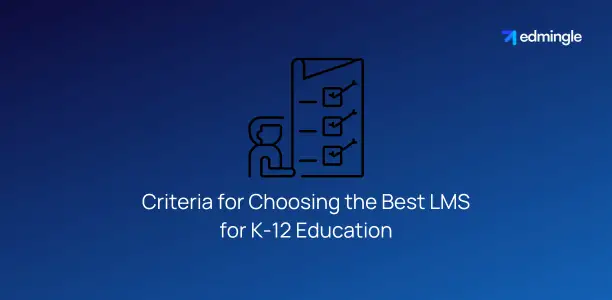
Choosing the best LMS for K-12 education requires careful consideration of several key criteria to ensure the platform meets the specific needs of young learners and educators.
Here are some things to consider before selecting a learning management system for K-12 needs:
- First, it should offer age-appropriate content and user-friendly interfaces that cater to the developmental stages of K-12 students.
- The LMS must provide robust features for content management, including the ability to create, customize, and distribute engaging and interactive learning materials.
- Another crucial factor is the system’s ability to track and report on student progress, offering tools for both academic and behavioral assessments.
- The LMS should facilitate effective communication and collaborative learning experience among students, teachers, and parents, enhancing the parental involvement.
- Additionally, it’s important to consider the LMS’s integration capabilities with other educational tools and its compliance with data privacy and security standards, especially given the age of the users.
- Lastly, the platform should be scalable and flexible, able to adapt to the evolving needs of the school and its students.
By evaluating these criteria, schools can select an LMS that not only enhances the learning experience but also supports the broader educational objectives of K-12 institutions.
Conclusion
As we conclude our exploration of learning management systems for K-12 education, it’s clear that the right LMS can be a game-changer for schools, educators, students, and parents alike.
When selecting an LMS, remember to consider the specific criteria that align with your school’s educational goals and the needs of your students.
The future of education is indeed digital. And, with the right LMS, your school can lead the way in providing an engaging, effective, and inclusive learning environment.
FAQs on LMS for K-12
Is Google Classroom a good LMS for K-12?
Yes, Google Classroom is a good option. It’s user-friendly and well-integrated. But, it’s not a true & proper LMS, due to limitations on its capabilities & functionalities.
How to select the right K-12 LMS for the benefit of schools and teachers?
Consider user-friendliness, content suitability, progress tracking, parental involvement, and data security when selecting a K-12 LMS.
Does a K-12 LMS offer features for both teachers and students?
Yes, a K-12 LMS offers diverse features catering to both teachers and students.
Can a K-12 LMS accommodate multiple types of educational content like videos, presentations, quizzes & assignments?
Yes, a K-12 LMS can accommodate various content types including videos, presentations, quizzes, and assignments.
Is a K-12 LMS compliant with school, teacher & student data privacy and security regulations?
Most modern K-12 LMS platforms are designed to comply with data privacy and security regulations relevant to schools.
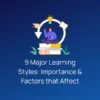
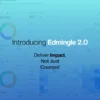
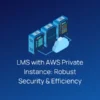
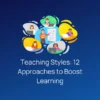

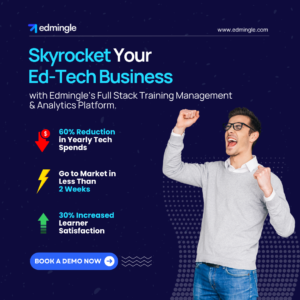
Leave a Reply